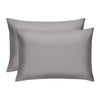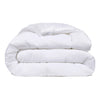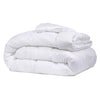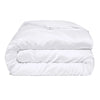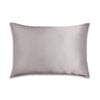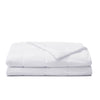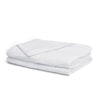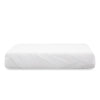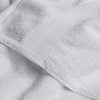The Daily Miracle
Performing An At Home Sleep Study
Published
June 08, 2021
Author
Nicholas Crusie

Sleep is your trusty sidekick when it comes to taking on the day and also has a significant impact on long-term health.
If you wake up every morning feeling fatigued or headache-y, obstructive sleep apnea (OSA) could be the culprit, and an at-home sleep study might be just what you need to do.
What Is Obstructive Sleep Apnea?
OSA is identified by a reduction or interruption to your breathing for longer than ten seconds at least five times per hour during your sleep. These interruptions prevent you from getting enough oxygen, resulting in short-term effects like a headache but also an increased risk of hypertension, diabetes, and other health complications.
Some Causes of Obstructive Sleep Apnea
When you sleep, your whole body relaxes. This means muscles such as the tongue or the soft tissue of the tonsils also relax, possibly blocking your airways. It is more likely to block depending on certain risk factors, such as a rounded head or a narrow throat passage. The decreased flow of oxygen caused by OSA can wake you up throughout the night, resulting in poor quality of sleep.
OSA may also be caused by allergies that inflame the nasal passages. While you can’t do much about the shape of your head or the diameter of your throat passage, you can reduce allergic reactions by cleaning your bedroom of dust and sleeping on clean bed linens, such as the Miracle Sheet set.
Infused with natural silver, the fabric inhibits bacterial growth that may contribute to allergies. While the anti-bacterial technology will reduce your allergic reactions and your laundry load, it is important to wash bed linens regularly to get rid of germs, pet hair, and other household allergens.
Symptoms of Obstructive Sleep Apnea
The possibility that you might not be breathing enough as you sleep is certainly a cause for concern, but it is also a surprisingly common issue. Roughly one in fifteen Americans experience OSA, with most cases going undiagnosed. Common symptoms to look out for include:
- Episodes of snoring
- Headache
- Irritability
- Forgetfulness
- Falling asleep during the day
*According to a medical study, OSA is the leading cause of daytime sleepiness.
If your significant other keeps elbowing you in the night to stop snoring or if you wake up experiencing one of the side effects listed above, you might have obstructive sleep apnea. While OSA is most common in middle to older age adults, there are a whole host of risk factors that might make you susceptible to this enemy of good sleep.
Diagnosing Obstructive Sleep Apnea
Before you can treat OSA, it is important to get a medically improved diagnosis. You’ll be glad to know this doesn’t have to mean an overnight stay at the hospital. An at-home sleep study is easy to set up and will help you determine pretty quickly whether or not it is OSA that is affecting your sleep.
While performing an at-home sleep study is pretty straightforward, it should be prescribed by a primary care physician or sleep clinic to ensure it is safe for you to use. Make an appointment with your doctor to see whether they recommend an at-home test to diagnose your sleeping or breathing issues. There are websites where you can buy the test without a doctor’s approval but consulting with your physician is always a good idea – especially if you have existing health problems or take certain medications.
What Exactly Is a Sleep Study?
Instead of having someone watch over you and monitor signs of obstructive sleep apnea – which would make it even harder to fall asleep! – an at-home sleep test uses sensors to measure your airflow.
At-home sleep study tests are a convenient alternative to lab-administered tests, which might alter your sleeping habits due to being in an unfamiliar, and likely less comfortable, location. It is certainly a good option for anyone who avoids hospitals at all costs. The at-home sleep study test is also a more affordable alternative to in-patient care, as it is self-administered and requires less equipment. What’s more, it is generally covered by health insurance.
How Does an At-Home Sleep Study Work?
The test comes with three components that are unobtrusive and easy to use. When attached to your body as you sleep, this clever device identifies pauses in your breathing pattern, the depth of your breathing, and the effort it takes for you to breathe as you sleep. Here’s what to expect when you set it up:
- A thin wire taped by your nose and mouth acts like a sensor to register your breathing patterns as you sleep. This component of the test registers your airflow.
- Elasticated belt bands placed around your chest area collect data on the effort your body requires to breathe properly during sleep. This component of the test measures respiratory effort.
- A finger clip, like those that monitor heart rate, helps measure the oxygen levels in your blood.
Similar in size to a telephone handset, the device is conveniently sized to prop on your bedside table and straightforward to use, meaning it won’t get in the way of your evening routine.
Preparing For The At-Home Sleep Study
While an at-home sleep study is unobtrusive and simple to administer, there are still a few tips you should follow to yield the most accurate results.
Avoid Caffeine
Consuming caffeine later in the day is thought to disrupt regular sleeping patterns. It is best to avoid coffee and caffeinated sodas and tea in the afternoon to prevent it from affecting your sleep.
No Napping
Taking a nap during the daytime will also impact how well you sleep at night. It is best to avoid taking a nap so you are sufficiently tired to have a full night of sleep while using the sleep test.
Don’t Sleep on Your Front
Obtrusive sleep apnea is exacerbated by sleeping on your back or side because these positions make it more likely for your tongue and soft palate to block the throat. While this is something you generally want to avoid, it is best to sleep in these positions to successfully measure the potential severity of your OSA.
It is also good to record your sleeping position at night as it will help the doctor identify the cause of your OSA. Make sure to sleep with the device attached for up to three nights to get the most accurate measure. It is possible that one of the components may fall off or come loose in the night, rendering an inaccurate reading of your sleep pattern.
Next Steps After Your Sleep Test
After a few nights of gathering data, remove the attached strip, bands, and finger clip from your body and re-pack the at-home sleep study test. It will need to be returned to the diagnostic service provider, who will download, process, and analyze the data to produce a comprehensive sleep report.
The severity of your OSA is classified by instances of hypopneas or apneas measured per hour and is determined using this scale. Your level of sleep apnea may be so mild that there is no need for medical intervention. However, if you have a severe case, it is important to see a specialist who can advise you on the best remedy.
A popular solution is the continuous positive airway pressure (CPAP) machine, where the user dons an around-the-face mask that supplies a continuous stream of oxygen to keep the airways open.
Final Takeaways
While at-home sleep study tests win points for convenience and affordability, they are limited to only diagnosing OSA. If you are not diagnosed, it may be frustrating exploring other avenues to discover the root of your sleep issues.
However, if you have a suspicion that OSA could be the reason behind your poor sleep, it is definitely worth investing in a couple of nights attached to some wires if it means you could improve your sleep – and health – from more serious problems.
Sources:
- Obstructive Sleep Apnea and Oxygen Therapy | NCBI
- Allergic Rhinitis Connected to Sleep Apnea | Koala® Center for Sleep
- Obstructive Sleep Apnea | MSD Manual Professional Edition
- Obstructive Sleep Apnea | Hopkins Medicine
- Insomnia and Excessive Daytime Sleepiness (EDS)| MSD Manual Professional Edition
- Diagnosis and Treatment of Obstructive Sleep Apnea | EuropeMC
- Obstructive Sleep Apnea Diagnosis and Management | NCBI


